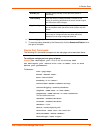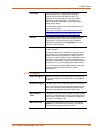
8: Device Ports
SLB™ Branch Office Manager User Guide 99
only the oldest data is lost, and only in the amount of overrun (not in large blocks of
memory).
NFS File Logging
Data can be logged to a file on a remote NFS server. Data logged locally to the SLB
branch office manager is limited to 256 Kbytes and may be lost in the event of a power
loss. Data logged to a file on an NFS server does not have these limitations. The system
administrator can define the directory for saving logged data on a port-by-port basis and
configure file size and number of files per port.
The directory path must be the local directory for one of the NFS mounts. For each
logging file, once the file size reaches the maximum, a new file opens for logging. Once
the number of files reaches the maximum, the oldest file is overwritten. The file naming
convention is: <Device Port Number>_<Device Port Name>_<File number>.log.
Examples: 02_Port-2_1.log
02_Port-2_2.log
02_Port-2_3.log
02_Port-2_4.log
02_Port-2_5.log
PC Card Logging
Data can be logged to a PC Card Compact Flash that is loaded into one of the PC Card
slots on the front of the SLB branch office manager and properly mounted (see PC Card
Logging on page 99). Data logged locally to the SLB device is limited to 256 Kbytes and
may be lost in the event of a power loss. Data logged to a PC Card Compact Flash does
not have these limitations. The system administrator can define the file size and number
of files per port. For each logging file, once the file size reaches the maximum, a new file
opens for logging. Once the number of files reaches the maximum, the oldest file is
overwritten. The file naming convention is: <Device Port Number>_<Device Port
Name>_<File number>.log.
Examples: 02_Port-2_1.log
02_Port-2_2.log
02_Port-2_3.log
02_Port-2_4.log
02_Port-2_5.log
Email/SNMP Notification
The system administrator can configure the SLB branch office manager to send an email
alert message indicating a particular condition detected in the device port log to the
appropriate parties or an SNMP trap to the designated NMS (see 7: Services). The email
or trap is triggered when a user-defined number of characters in the log from your server
or device is exceeded, or a specific sequence of characters is received.
Use the Device Ports – Logging page to set logging parameters on individual ports.


















